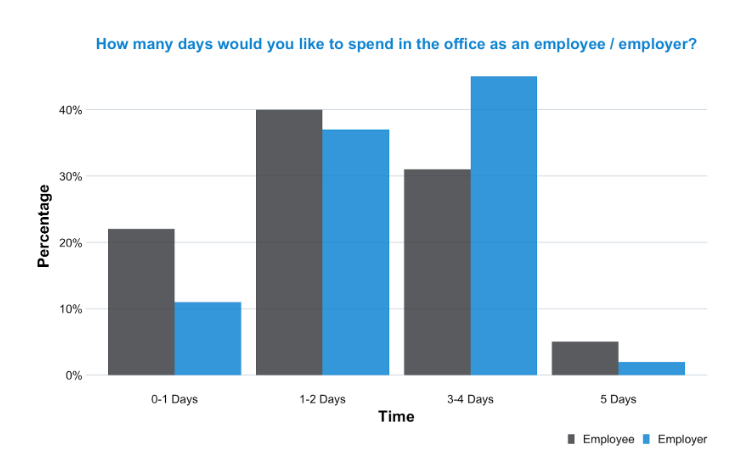Hybrid working is here to stay. Although many organisations offer hybrid work arrangements, there are still some ongoing challenges. Specifically, organisations have observed misalignment and even tension between managers and employees about their preferred number of days in the office. This is described in detail in the recent RMIT report, The Office Clash. In the current climate of the Great Resignation and ongoing labour shortages, managers need to think carefully about how they resolve this misalignment.
Managers and employees are misaligned on how many days they should work from the office
The RMIT survey, which was conducted with 800 respondents, found that managers and employees are misaligned on a number of factors related to hybrid working. Managers and employees differ in their perception of the importance of working in the office, their view of motivations for working from home, and their preferences regarding the number of days they work at home versus in the office.
Interestingly, when we ran a survey at a thought leadership event with 185 managers, we found that they have different expectations for the amount of time that employees and employers should spend in the office on average. We asked managers how many days they would like to spend in the office as an employer, and then asked them how many days they would like to spend in the office as employees. This framing changed their answers! 
Some organisations have responded to this misalignment by providing a high degree of employee choice – but there are risks with a totally ‘hands-off’ approach
The RMIT survey found that 66% of organisations with hybrid work models provide some level of employee choice. Of these, about one-third give employees complete control over when they are in this office. While employee choice is incredibly important, there is a risk that too much choice can create choice overload or inertia. In these scenarios, some employees might not end up going into the office very much at all.
Emerging research has shown that there are some risks with having significant variability in how often different groups come into the office. If some people consistently work from home more often, there are likely to be long-term impacts on their careers. Our own work has found that people with dependants and/or disabilities are more likely to favour a greater number of days working from home. Organisations should continually monitor the outcomes of hybrid working, to ensure that it doesn’t entrench inequities. If these unintended outcomes are observed, organisations should act quickly to resolve them. If your organisation fails to keep an eye on this, it may exacerbate inequities and make your company a less appealing place to work in the long-term.
A hands-off approach to hybrid work may also hurt your company’s bottom line. There is plenty of evidence that collaboration leads to innovation, but this can be harder to do in hybrid environments. A study of Microsoft employees in 2020 found firm-wide remote working resulted in collaboration networks becoming more static and siloed, with fewer bridges between different divisions. Therefore, a totally hands-off approach to working from home without careful planning could significantly reduce creativity and innovation in your organisation.
When providing significant employee choice, softer nudges may be needed to overcome work from home inertia and ensure employees experience the benefits of working from the office
We recently presented to organisations about how they can apply behavioural insights to encourage employees to return to the office. By using ‘nudges’, organisations are able to preserve employee flexibility and choice, while effectively addressing common barriers to coming into the office. For example, organisations should ensure senior manager attendance in the office is visible, as they are important role models. Our previous trials on increasing uptake of flexible work have shown that employees are highly influenced by the work patterns of managers (see the Harvard Business Review article for more information about our trial).
Download the infographic here for simple, evidence-based solutions to encourage your teams to come into the office more often
 When encouraging employees to return to the office, it is important to ensure the environment is safe – from COVID and the flu
When encouraging employees to return to the office, it is important to ensure the environment is safe – from COVID and the flu
In the middle of 2022, many organisations are well-versed in strategies and practices to keep the workplace COVID-safe. However, a key concern this winter season is the flu. In Australia, we’ve already seen low uptake of vaccinations and a significant increase in workplace sick leave. These trends could soon be replicated in the northern hemisphere later this year. Many of the practices and behaviours that protect us from COVID can also be effective in reducing the risk of catching the flu.
Download the infographic here for strategies to encourage COVID-safe – and flu-safe – behaviours in your workplace (beyond providing extra hand sanitiser!)

If your organisation is looking for support to embed, review or improve hybrid ways of working – including monitoring and responding to inequities – please reach out to us.





